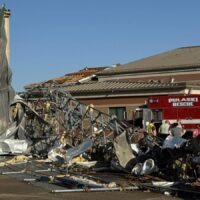Officials from communities across the state are contributing to a new disaster preparedness resource being developed by the Kentucky League of Cities to better share know-how gained from leading their cities and counties through natural, financial and cyber disasters.
The yet-to-be-named resource — set to be presented during the organization’s annual Conference & Expo in Lexington this September — won’t be a step by step walkthrough for officials, but will instead be a compendium of advice and actions taken by other officials in a variety of emergency circumstances.
Morgain Patterson is the director of municipal law for the Kentucky League of Cities. She said KLC leadership has been considering the potential project for years to aid officials in member cities so they’re not “caught flat-footed” in a crisis.
“Cities are increasingly dealing with disasters, both natural and other types of disasters … from the tornadoes and flooding, to electronic disasters, such as having their data stolen, or all of their electronic information frozen, and even substantial economic disasters, such as your primary economic engine picking up and moving from your city,” Patterson said. “Our executive team wanted to put together a disaster preparedness handbook as a resource for city officials … a reference for cities that they can literally just take off the shelf and use from day one of the disaster.”
Patterson said the guide will help local officials navigate the complex minutiae of disasters, like Federal Emergency Management Agency (FEMA) paperwork and requests, what to do if government facilities are destroyed in a disaster and what questions to ask different officials to get aid.
To do this, Patterson has formed a KLC committee to include officials who’ve been through disasters. People like Mayfield Mayor Kathy O’Nan, who led her far Western Kentucky city in the wake of a long-track EF-4 tornado going straight through its historic downtown area in December 2021.
Most communities already have disaster plans in place for when emergency strikes. O’Nan said this resource isn’t meant to take the place of those plans, but to be used in addition to them.
“It gives you a place to start. It would have given me a place to start. That first day I felt like I was riding an ocean wave because I knew that [the] emergency management system was in charge, but there were so many people in the emergency operating center, that I didn’t know who to go to for questions.”
The resource will be a working document that KLC regularly works with to refresh with federal, state and local officials, an aspect that O’Nan thinks is crucial to the resource’s usefulness.
“Each disaster is different,” O’Nan said. “People will learn more, as there’s disasters [that] hit their communities, whether it’s a tornado, an earthquake, a gas leak, a train derailment, anything, so you would just probably add to that and say, ‘Okay, in this case, this is what they did.’”
Graves County Emergency Management Director Tracy Warner said including advice on how to navigate FEMA will make the resource invaluable for communities that experience large-scale natural disasters.
“There’s just so much out there that you could lose out on a lot of stuff,” she said. “[FEMA officials] wanted us to ask certain questions. Well, we didn’t know what to ask … because we didn’t know what the choices were. Just knowing some of the parts, it would have been so much simpler if we didn’t have to figure it all out and had a guide to kind of go by.”
Warner thinks that this resource will help local leaders feel less overwhelmed in the wake of disasters, as she sometimes did in the wake of the tornado outbreak.
“It was hard. Sometimes we would get frustrated and so we’re hoping that, by doing this, that we can take some of that frustration out for other people,” she said. “They’ll have something they can look at and help manage what they’re going through and they won’t have the frustrations that we had of not knowing all the parts that we could have utilized and making sure that you get the full benefit that’s there.”
Other committee members include former and current law enforcement officers, emergency management professionals and officials from cities in Lawrence, Jefferson and McCracken counties, as well as Floyd and Letcher counties, which were heavily impacted by the 2022 Eastern Kentucky floods.
“We’ve included officials from all over to make sure that we have people with a variety of backgrounds,” Patterson said. “We have people who’ve been through you know, the flooding, the tornadoes, we have people who have assisted who’ve also been through FEMA training or have other backgrounds. We tried to pull from all different types of experiences, backgrounds and the like to get a broad perspective on the approaches and put together something that cities can really use going forward.”






